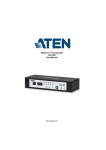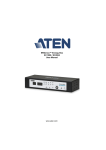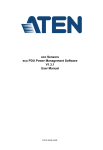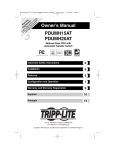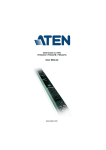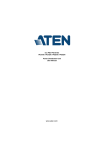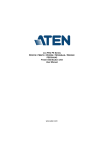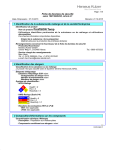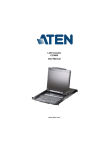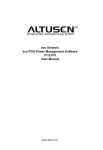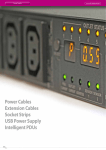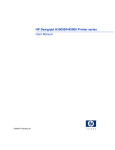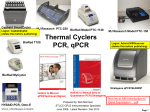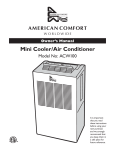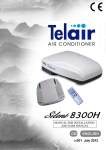Download NRGence™ eco PDU PE Series PE5220s / PE5312sGL
Transcript
NRGence™ eco PDU PE Series
PE5220s / PE5312sGL / PE5312sGR / PE5340s
Power Distribution Unit
User Manual
www.aten.com
eco PDU PE Series User Manual
FCC, CE Information
FEDERAL COMMUNICATIONS COMMISSION INTERFERENCE
STATEMENT: This equipment has been tested and found to comply with the
limits for a Class A digital device, pursuant to Part 15 of the FCC Rules. These
limits are designed to provide reasonable protection against harmful
interference when the equipment is operated in a commercial environment.
This equipment generates, uses, and can radiate radio frequency energy and, if
not installed and used in accordance with the instruction manual, may cause
harmful interference to radio communications. Operation of this equipment in
a residential area is likely to cause harmful interference in which case the user
will be required to correct the interference at his own expense.
FCC Caution: Any changes or modifications not expressly approved by the
party responsible for compliance could void the user's authority to operate this
equipment.
CE Warning: This is a class A product. In a domestic environment this product
may cause radio interference in which case the user may be required to take
adequate measures.
RoHS
This product is RoHS compliant.
SJ/T 11364-2006
The following contains information that relates to China.
ii
eco PDU PE Series User Manual
User Information
Online Registration
Be sure to register your product at our online support center:
International
http://eservice.aten.com
Telephone Support
For telephone support, call this number:
International
886-2-8692-6959
China
86-10-5255-0110
Japan
81-3-5615-5811
Korea
82-2-467-6789
North America
1-888-999-ATEN ext 4988
United Kingdom
44-8-4481-58923
User Notice
All information, documentation, and specifications contained in this manual are subject to change
without prior notification by the manufacturer. The manufacturer makes no representations or
warranties, either expressed or implied, with respect to the contents hereof and specifically
disclaims any warranties as to merchantability or fitness for any particular purpose. Any of the
manufacturer's software described in this manual is sold or licensed as is. Should the programs
prove defective following their purchase, the buyer (and not the manufacturer, its distributor, or its
dealer), assumes the entire cost of all necessary servicing, repair and any incidental or
consequential damages resulting from any defect in the software.
The manufacturer of this system is not responsible for any radio and/or TV interference caused by
unauthorized modifications to this device. It is the responsibility of the user to correct such
interference.
The manufacturer is not responsible for any damage incurred in the operation of this system if the
correct operational voltage setting was not selected prior to operation. PLEASE VERIFY THAT
THE VOLTAGE SETTING IS CORRECT BEFORE USE.
iii
eco PDU PE Series User Manual
PE Device Safety Notice
Set the maximum permissible breaker protection in the building circuitry to the
current rating specified on the rating plate. Observe all national regulations and
safety codes as well as deviations for breakers.
Only connect the PE Device to a grounded power outlet or a grounded system!
Make sure that the total current input of the connected systems does not exceed
the current rating specified on the rating plate of the PE Device.
There is a risk of explosion if the battery is replaced with an incorrect type.
Dispose of used batteries according to the relevant instructions.
Consignes de sècuritè relatives à l’unitè PE
Installez sur le circuit du bâtiment des disjoncteurs permettant d’assurer la
protection maximale autorisée, en respectant le courant nominal spécifié sur la
plaque signalétique. Veuillez respecter l’ensemble des réglementations nationales
en vigueur et des codes de sécurité ainsi que les déviations recommandèes pour
les disjoncteurs.
Ne connectez l’unité PE qu’à une prise de courant avec borne de terre ou à un
système mis à la terre!
Assurez-vous que le courant d’entrée total des systèmes connectés ne dépasse pas
le courant nominal spécifié sur la plaque signalétique de l’unité PE.
Il existe un risque d’explosion si la batterie est remplacée par une batterie de type
incorrect. Jetez les batteries usagées en respectant les instructions adequates.
iv
eco PDU PE Series User Manual
Package Contents
The eco PDU PE Series package consists of:
1 PE5220s, PE5312sGL, PE5312sGR, or PE5340s Power Distribution Unit
1 Power Cord (PE5220s only)
1 Rack Mount Kit
1 User Instructions*
1 CD-ROM
Check to make sure that all of the components are present and in good order.
If anything is missing, or was damaged in shipping, contact your dealer.
Read this manual thoroughly and follow the installation and operation
procedures carefully to prevent any damage to the eco PDU or other devices on
the installation.
* Features may have been added to the eco PDU since this manual was
published. Please visit our website to download the most up-to-date version.
Copyright © 2013 ATEN® International Co., Ltd.
Manual Date: 2013-12-23
NRGence and the NRGence logo are registered trademarks of ATEN International Co., Ltd. All rights reserved.
All other brand names and trademarks are the registered property of their respective owners.
v
eco PDU PE Series User Manual
Contents
FCC, CE Information . . . . . . . . . . . . . . . . . . . . . . . . . . . . . . . . . . . . . . . . . ii
SJ/T 11364-2006 . . . . . . . . . . . . . . . . . . . . . . . . . . . . . . . . . . . . . . . . . . . . ii
User Information . . . . . . . . . . . . . . . . . . . . . . . . . . . . . . . . . . . . . . . . . . . . iii
Online Registration . . . . . . . . . . . . . . . . . . . . . . . . . . . . . . . . . . . . . . . . iii
Telephone Support . . . . . . . . . . . . . . . . . . . . . . . . . . . . . . . . . . . . . . . . iii
User Notice . . . . . . . . . . . . . . . . . . . . . . . . . . . . . . . . . . . . . . . . . . . . . . iii
PE Device Safety Notice . . . . . . . . . . . . . . . . . . . . . . . . . . . . . . . . . . .iv
Consignes de sècuritè relatives à l’unitè PE . . . . . . . . . . . . . . . . . . . . .iv
Package Contents . . . . . . . . . . . . . . . . . . . . . . . . . . . . . . . . . . . . . . . . . . . v
About This Manual . . . . . . . . . . . . . . . . . . . . . . . . . . . . . . . . . . . . . . . . . . .ix
Conventions . . . . . . . . . . . . . . . . . . . . . . . . . . . . . . . . . . . . . . . . . . . . .ix
Product Information . . . . . . . . . . . . . . . . . . . . . . . . . . . . . . . . . . . . . . . . . . x
Chapter 1.
Introduction
Overview. . . . . . . . . . . . . . . . . . . . . . . . . . . . . . . . . . . . . . . . . . . . . . . . . . . 1
Comparison Charts . . . . . . . . . . . . . . . . . . . . . . . . . . . . . . . . . . . . . . . . . . 3
PE5220sA / PE5220sB / PE5220sA-AX-J / PE5220sB-AX-J / PE5220sG
Comparison Chart . . . . . . . . . . . . . . . . . . . . . . . . . . . . . . . . . . . . . . . . . 3
PE5312sGL / PE5312sGR Comparison Chart . . . . . . . . . . . . . . . . . . . 3
PE5340sB / PE5340sG / PE5340sJ Comparison Chart . . . . . . . . . . . 4
Features . . . . . . . . . . . . . . . . . . . . . . . . . . . . . . . . . . . . . . . . . . . . . . . . . . . 5
Power Distribution . . . . . . . . . . . . . . . . . . . . . . . . . . . . . . . . . . . . . . . . 5
Remote Access . . . . . . . . . . . . . . . . . . . . . . . . . . . . . . . . . . . . . . . . . . . 5
Operation . . . . . . . . . . . . . . . . . . . . . . . . . . . . . . . . . . . . . . . . . . . . . . . 5
Management . . . . . . . . . . . . . . . . . . . . . . . . . . . . . . . . . . . . . . . . . . . . 6
Security . . . . . . . . . . . . . . . . . . . . . . . . . . . . . . . . . . . . . . . . . . . . . . . . 6
eco Sensors Energy Management Software* . . . . . . . . . . . . . . . . . . . 6
Requirements . . . . . . . . . . . . . . . . . . . . . . . . . . . . . . . . . . . . . . . . . . . . . . 7
Optional Accessories . . . . . . . . . . . . . . . . . . . . . . . . . . . . . . . . . . . . . . . . . 8
Sensors . . . . . . . . . . . . . . . . . . . . . . . . . . . . . . . . . . . . . . . . . . . . . . . . 8
Cable Holders . . . . . . . . . . . . . . . . . . . . . . . . . . . . . . . . . . . . . . . . . . . 8
Components . . . . . . . . . . . . . . . . . . . . . . . . . . . . . . . . . . . . . . . . . . . . . . . 9
PE5220sB-AX-J / PE5220sB / PE5220sG Front View . . . . . . . . . . . . . 9
PE5220sA-AX-J / PE5220sA Front View . . . . . . . . . . . . . . . . . . . . . . 11
PE5312sGL Front View . . . . . . . . . . . . . . . . . . . . . . . . . . . . . . . . . . . 13
PE5312sGR Front View . . . . . . . . . . . . . . . . . . . . . . . . . . . . . . . . . . . 15
PE5340s Front View . . . . . . . . . . . . . . . . . . . . . . . . . . . . . . . . . . . . . 17
PE5220s Readout Section . . . . . . . . . . . . . . . . . . . . . . . . . . . . . . . . . 19
PE5312s / PE5340s Readout Section . . . . . . . . . . . . . . . . . . . . . . . . 20
Chapter 2.
Hardware Setup
Before You Begin . . . . . . . . . . . . . . . . . . . . . . . . . . . . . . . . . . . . . . . . . . . 21
vi
eco PDU PE Series User Manual
Rack Mounting . . . . . . . . . . . . . . . . . . . . . . . . . . . . . . . . . . . . . . . . . . . . . 21
PDU Placement . . . . . . . . . . . . . . . . . . . . . . . . . . . . . . . . . . . . . . . . . . . . 22
Installation . . . . . . . . . . . . . . . . . . . . . . . . . . . . . . . . . . . . . . . . . . . . . . . . 23
Securing the Cables . . . . . . . . . . . . . . . . . . . . . . . . . . . . . . . . . . . . . . 25
Securing the Sensors . . . . . . . . . . . . . . . . . . . . . . . . . . . . . . . . . . . . . 26
Chapter 3.
Basic Operation and
First Time Setup
Operation Methods . . . . . . . . . . . . . . . . . . . . . . . . . . . . . . . . . . . . . . . . . . 27
Browser . . . . . . . . . . . . . . . . . . . . . . . . . . . . . . . . . . . . . . . . . . . . . . . 27
eco Sensors . . . . . . . . . . . . . . . . . . . . . . . . . . . . . . . . . . . . . . . . . . . . 27
SNMP . . . . . . . . . . . . . . . . . . . . . . . . . . . . . . . . . . . . . . . . . . . . . . . . . 27
First Time Setup . . . . . . . . . . . . . . . . . . . . . . . . . . . . . . . . . . . . . . . . . . . . 28
Network Configuration . . . . . . . . . . . . . . . . . . . . . . . . . . . . . . . . . . . . 29
Changing the Administrator Login . . . . . . . . . . . . . . . . . . . . . . . . . . . 30
Moving On. . . . . . . . . . . . . . . . . . . . . . . . . . . . . . . . . . . . . . . . . . . . . . . . . 30
Chapter 4.
Browser Operation
Logging In . . . . . . . . . . . . . . . . . . . . . . . . . . . . . . . . . . . . . . . . . . . . . . . . . 31
The eco PDU Main Page . . . . . . . . . . . . . . . . . . . . . . . . . . . . . . . . . . . . . 32
Page Components. . . . . . . . . . . . . . . . . . . . . . . . . . . . . . . . . . . . . . . . 32
Outlet Access . . . . . . . . . . . . . . . . . . . . . . . . . . . . . . . . . . . . . . . . . . . . . . 34
Connections . . . . . . . . . . . . . . . . . . . . . . . . . . . . . . . . . . . . . . . . . . . . 34
Bank Status . . . . . . . . . . . . . . . . . . . . . . . . . . . . . . . . . . . . . . . . . . . . 36
Configuration . . . . . . . . . . . . . . . . . . . . . . . . . . . . . . . . . . . . . . . . . . . 37
User . . . . . . . . . . . . . . . . . . . . . . . . . . . . . . . . . . . . . . . . . . . . . . . . . . . . . 38
Administrator Information . . . . . . . . . . . . . . . . . . . . . . . . . . . . . . . . . . 38
User Information . . . . . . . . . . . . . . . . . . . . . . . . . . . . . . . . . . . . . . . . . 39
Log . . . . . . . . . . . . . . . . . . . . . . . . . . . . . . . . . . . . . . . . . . . . . . . . . . . . . . 40
The System Log Event List . . . . . . . . . . . . . . . . . . . . . . . . . . . . . . . . . 40
Setup . . . . . . . . . . . . . . . . . . . . . . . . . . . . . . . . . . . . . . . . . . . . . . . . . . . . 41
Device Configuration . . . . . . . . . . . . . . . . . . . . . . . . . . . . . . . . . . . . . . 41
Date/Time . . . . . . . . . . . . . . . . . . . . . . . . . . . . . . . . . . . . . . . . . . . . . . 47
Security . . . . . . . . . . . . . . . . . . . . . . . . . . . . . . . . . . . . . . . . . . . . . . . 49
Login Failures . . . . . . . . . . . . . . . . . . . . . . . . . . . . . . . . . . . . . . . . . . . 49
Working Mode . . . . . . . . . . . . . . . . . . . . . . . . . . . . . . . . . . . . . . . . . . 49
Account Policy . . . . . . . . . . . . . . . . . . . . . . . . . . . . . . . . . . . . . . . . . . 50
Login String / IP Filter / Mac Filter . . . . . . . . . . . . . . . . . . . . . . . . . . . 51
Authentication & Authorization . . . . . . . . . . . . . . . . . . . . . . . . . . . . . . 54
Private Certificate . . . . . . . . . . . . . . . . . . . . . . . . . . . . . . . . . . . . . . . . 56
PDU . . . . . . . . . . . . . . . . . . . . . . . . . . . . . . . . . . . . . . . . . . . . . . . . . . . . . 57
Firmware File. . . . . . . . . . . . . . . . . . . . . . . . . . . . . . . . . . . . . . . . . . . . 57
Backup/Restore . . . . . . . . . . . . . . . . . . . . . . . . . . . . . . . . . . . . . . . . . 59
vii
eco PDU PE Series User Manual
Appendix
Safety Instructions . . . . . . . . . . . . . . . . . . . . . . . . . . . . . . . . . . . . . . . . . . 61
General . . . . . . . . . . . . . . . . . . . . . . . . . . . . . . . . . . . . . . . . . . . . . . . 61
Consignes de sécurité . . . . . . . . . . . . . . . . . . . . . . . . . . . . . . . . . . . . . . . 63
Général . . . . . . . . . . . . . . . . . . . . . . . . . . . . . . . . . . . . . . . . . . . . . . . 63
Rack Mounting . . . . . . . . . . . . . . . . . . . . . . . . . . . . . . . . . . . . . . . . . . 66
The eco PDU’s Main Power Cord . . . . . . . . . . . . . . . . . . . . . . . . . . . 66
Securing the Power Cables . . . . . . . . . . . . . . . . . . . . . . . . . . . . . . . . 66
Montage sur bâti . . . . . . . . . . . . . . . . . . . . . . . . . . . . . . . . . . . . . . . . 67
Le cordon d’alimentation principale de l’unité d’alimentation éco . . . . 67
Fixation des câbles d’alimentation . . . . . . . . . . . . . . . . . . . . . . . . . . . 67
Technical Support . . . . . . . . . . . . . . . . . . . . . . . . . . . . . . . . . . . . . . . . . . 69
International . . . . . . . . . . . . . . . . . . . . . . . . . . . . . . . . . . . . . . . . . . . . 69
North America . . . . . . . . . . . . . . . . . . . . . . . . . . . . . . . . . . . . . . . . . . 69
IP Address Determination . . . . . . . . . . . . . . . . . . . . . . . . . . . . . . . . . . . . 70
Specifications . . . . . . . . . . . . . . . . . . . . . . . . . . . . . . . . . . . . . . . . . . . . . . 72
PE5220sA / PE5220sA-AX-J . . . . . . . . . . . . . . . . . . . . . . . . . . . . . . . 72
PE5220sB / PE5220sB-AX-J . . . . . . . . . . . . . . . . . . . . . . . . . . . . . . . 73
PE5220sG . . . . . . . . . . . . . . . . . . . . . . . . . . . . . . . . . . . . . . . . . . . . . 74
PE5312sGL . . . . . . . . . . . . . . . . . . . . . . . . . . . . . . . . . . . . . . . . . . . . 75
PE5312sGR . . . . . . . . . . . . . . . . . . . . . . . . . . . . . . . . . . . . . . . . . . . . 76
PE5340sB / PE5340sJ . . . . . . . . . . . . . . . . . . . . . . . . . . . . . . . . . . . . 77
PE5340sG . . . . . . . . . . . . . . . . . . . . . . . . . . . . . . . . . . . . . . . . . . . . . 78
Administrator Login Failure . . . . . . . . . . . . . . . . . . . . . . . . . . . . . . . . . . . 79
Limited Warranty . . . . . . . . . . . . . . . . . . . . . . . . . . . . . . . . . . . . . . . . . . . 80
viii
eco PDU PE Series User Manual
About This Manual
This User Manual is provided to help you get the most from your eco PDU
system. It covers all aspects of installation, configuration and operation. An
overview of the information found in the manual is provided below.
Chapter 1, Introduction, introduces you to the eco PDU system. Its purpose,
features and benefits are presented, and its front and back panel components
are described.
Chapter 2, Hardware Setup, provides step-by-step instructions for setting
up your installation.
Chapter 3, Basic Operation and First Time Setup, explains the
procedures that the Administrator employs to set up the eco PDU network
environment, and change the default username and password.
Chapter 4, Browser Operation, describes how to log in to the eco PDU with
an internet browser, and explains the layout and components of the eco PDU’s
user interface.
An Appendix, provides specifications and other technical information
regarding the eco PDU.
Conventions
This manual uses the following conventions:
Monospaced
Indicates text that you should key in.
[]
Indicates keys you should press. For example, [Enter] means
to press the Enter key. If keys need to be chorded, they
appear together in the same bracket with a plus sign
between them: [Ctrl+Alt].
1.
Numbered lists represent procedures with sequential steps.
♦
Bullet lists provide information, but do not involve sequential
steps.
→
Indicates selecting the option (on a menu or dialog box, for
example), that comes next. For example, Start → Run
means to open the Start menu, and then select Run.
Indicates critical information.
ix
eco PDU PE Series User Manual
Product Information
For information about all NRGence™ products and how they can help you
save money in the data center, visit NRGence™ on the Web or contact an
ATEN Authorized Reseller. Visit ATEN on the Web for a list of locations and
telephone numbers
International – http://www.aten.com
North America – http://www.aten-usa.com
x
Chapter 1
Introduction
Overview
As part of its NRGence™ line, ATEN has developed a new generation of green
energy power distribution units (PDUs) to effectively increase the efficiency of
data center power usage. The NRGence™ PE5220s, PE5312sGL,
PE5312sGR, and PE5340s are intelligent PDUs that contain 12/20/40 AC
outlets and are available in IEC or NEMA input configurations. The basic
characteristics of each model are shown in the tables on page 4.
The PE5220s, PE5312sGL, PE5312sGR, and PE5340s provide secure,
centralized, intelligent, power management of data center IT equipment
(servers, storage systems, KVM switches, network devices, serial data devices,
etc.), as well as the ability to monitor the data center's environmental health via
sensors*.
NRGence™ eco PDUs offer remote power control combined with real-time
power measurement - allowing you to control and monitor the power status of
devices attached to the PDUs, either at the PDU device or bank level, from
practically any location via a TCP/IP connection.
The eco PDU also offers comprehensive power analysis reports which can
separate departments and locations, providing precise measurements of
current, voltage, power and watt-hour in a real-time display.
Installation and operation is fast and easy: plugging cables into their
appropriate ports and user-friendly browser-based management is all that is
entailed. Since the eco PDU firmware is upgradeable over the net, you can stay
current with the latest improvements by simply downloading updates from our
website as they become available.
NRGence™ eco PDUs support any 3rd party V1, V2, V3 SNMP Manager
Software and NRGence™ eco Sensors software (eco PDU Manager Software).
eco Sensors provide you with an easy method for managing multiple devices,
offering an intuitive and user-friendly Graphical User Interface that allows you
to configure a PDU device and monitor the power status of the equipment
connected to it.
(Continues on next page.)
1
eco PDU PE Series User Manual
(Continued from previous page.)
With its advanced security features and ease of operation, the PE5220s
PE5312sGL, PE5312sGR, and PE5340s eco PDUs are the most convenient,
most reliable, and most cost effective way to remotely manage power access
for multiple computer installations and allocate power resources in the most
efficient way possible.
Note: 1. Sensors are optional accessories. A sensor-enabled installation is
required to generate more complete energy-efficient data readings
and charts. Higher sensor installation density is helpful to generate
more accurate data. See Optional Accessories, page 8, for further
information.
2. eco PDUs are primarily designed for access via Intranet; extra
network security protection is suggested for Internet access usage.
2
Chapter 1. Introduction
Comparison Charts
PE5220sA / PE5220sB / PE5220sA-AX-J / PE5220sB-AX-J /
PE5220sG Comparison Chart
Amps
Metering Level
Model
Inlet / Cord
Outlets
PE5220sA
NEMA 5-20P
PE5220sB
NEMA 6-20P
IEC C13
12A (UL),
15A (Max)
PE5220sAAX-J
NEMA L520P
NEMA 5-15R
PE5220sBAX-J
NEMA L620P
PE5220sG
IEC 60320
C20
Per Duplex
Receptacle
Outlet
Bank
Total
12A (UL),
15A (Max).
{Per
outlet}
16A
(UL),
20A
(Max)
16A
(UL),
20A
(Max)
12A (UL),
15A (Max).
{Per
outlet}
16A
(UL),
20A
(Max)
16A
(UL),
20A
(Max)
IEC C13
12A (UL),
15A (Max)
16A
(UL),
20A
(Max)
16A
(UL),
20A
(Max)
IEC C13
10A
15A
(CB),
16A
(Max)
15A
(CB),
16A
(Max)
20 NEMA 5-15R Bank
PE5312sGL / PE5312sGR Comparison Chart
Model
Inlet / Cord
PE5312sGL IEC 60309
32A
Outlets
12
Bank1: Outlet
1–6 ; 6 x UK
BS1363
Metering
Level
Bank
Amps
Per Outlet
Bank
Total
BS1363:
13A (Max)
16A
(Max),
TUV Derated 15A
(Max)
32A
(Max),
TUV
Derated
30A
(Max)
BS1363:
13A (Max)
16A
(Max),
TUV Derated 15A
(Max)
32A
(Max),
TUV
Derated
30A
(Max)
Bank2: Outlet
7 –12 ; 6 x UK
BS1363
PE5312sGR IEC 60309
32A
Bank1: Outlet
1–6 ; 6 x UK
BS1363
Bank2: Outlet
7 –12 ; 6 x UK
BS1363
3
eco PDU PE Series User Manual
PE5340sB / PE5340sG / PE5340sJ Comparison Chart
Amps
Model
Inlet / Cord
PE5340sB NEMA L6-30P
Outlets
40
PE5340sJ
Bank 1:
Outlet 1–20:
20 x C13
PE5340sG IEC 60309
32A
Bank 2:
Outlet 21–40:
20 x C13
Metering
Level
Bank
Per Duplex
Receptacle
Outlet
Bank
Total
12A (UL),
15A (Max)
12A
(UL),
15A
(Max)
24A
(UL),
30A
(Max)
10A
15A
(TUV)
16A
(Max)
30A
(TUV)
32A
(Max)
Note: The PE5340sJ is identical to the B model but has power cords designed
for the Japanese market. For the complete specifications of individual
models, please reference Specifications, page 72.
4
Chapter 1. Introduction
Features
Power Distribution
Space saving 0U rack mount design with rear mounting
IEC or NEMA outlet models
3 digit 7-segment front panel LED shows PDU/Phase / Bank / IP
(PE5312sGL/PE5312sGR/PE5340s), or PDU Amp / IP (PE5220s)
Remote users can monitor PDU / Bank status via web GUI from most
internet browsers
Safe shutdown support
Separate power for the unit's own power and its power outlets. The user
interface is still accessible even when an overload condition trips the
devices' circuit breaker
Remote Access
Remote power control via TCP/IP and a built in 10/100 Ethernet port
Network Protocols: TCP/IP, UDP, HTTP, HTTPS, SSL, SMTP, DHCP,
NTP, DNS, auto sense, Ping
eco PDU Power Management software – eco Sensors
Supports SNMP Manager V1, V2 & V3
Operation
Supports multiple power control methods – Wake on LAN, System after
AC Back, Kill the Power
Power-on sequencing – users can set the power on sequence and delay
time for each port to allow equipment to be turned on in the proper order
Easy setup and operation via a browser-based user interface
Multibrowser support (IE, Mozilla, Firefox, Chrome, Safari, Opera,
Netscape)
RTC support to keep the timer running during times of no power.
Supports up to 8 user accounts and 1 administrator account; supports 2
concurrent logins
5
eco PDU PE Series User Manual
Management
Power status measurement at the PDU/Bank level
LED indicators for current and IP address at the PDU device and at the
Bank (PE5340s only) level
Real-time aggregate current, voltage, power, and power dissipation
displayed in a browser-based UI for monitoring at the PDU and bank level.
Environment monitoring – supports external temperature / humidity /
differential pressure sensors for rack environment monitoring
Current and voltage threshold setting
Naming support for outlets
User outlet access assignment on an outlet-by-outlet basis.
Event logging and syslog support
Upgradeable firmware
Multilanguage support: English, Traditional Chinese, Simplified Chinese,
Japanese, German, Italian, Spanish, French, Russian, Korean, Portuguese.
Security
Two-level password security
Strong security features include strong password protection and advanced
encryption technologies – 128 bit SSL
Remote authentication support: RADIUS
eco Sensors Energy Management Software*
Automatic discovery of all PE devices within the same intranet
Remote real-time power measurement and monitoring
Real-time environment sensor monitoring
Plotting/monitoring of all PE devices
Exceed threshold alert through SMTP and System log
Power Analysis report
Note: eco Senors is designed to work with NRGence™ PDUs, and is bundled
with all PE series packages.
6
Chapter 1. Introduction
Requirements
Browsers accessing the eco PDU unit must support SSL 128 bit
encryption.
For cold booting of attached computers, the computer's BIOS must
support Wake on LAN or System after AC Back.
For Safe Shutdown:
The computer must be running Windows (Windows 2000 or higher) or
Linux.
The Safe Shutdown program (available by download from our website
or on the software CD included), must be installed and running on the
computer.
7
eco PDU PE Series User Manual
Optional Accessories
Sensors
Sensors are optional accessories. You can use the eco PDU unit without
sensors. However, if you want to have complete energy management of an
instrumented data center with the use of the eco PDU, you would need to use
eco Sensors software and install 4 sensors for each of the racks to generate a
complete energy-efficient data reading and chart. Higher sensor installation
density is helpful to generate more accurate data. 16/20/24-port models have 2
sensor ports. In this case, Sensor 1 needs to be installed at the intake of the rack
and sensor 2 needs to be placed at the exhaust of IT equipment of the rack. A
sensor-enabled installation is required to generate a more complete energyefficient data reading and chart. Higher sensor installation density is helpful to
generate more accurate data. Available sensors are show in the table, below:
Sensor
Part Number
Temperature
EA1140
Temperature / Humidity
EA1240
Differential Pressure / Temperature
EA1340
Sensor Management
Sensors can be managed via the eco PDU’s built-in graphical user interface
(GUI) or with the NRGence™ eco Sensors software that can be downloaded
from the ATEN website. The download link can be found on the software CD
provided with the eco PDU package.
Cable Holders
Cable holders are optional accessories. For added safety, use ATEN Lok-UPlug cable holders to secure the cables from your attached devices in place on
the eco PDU unit. Use only the ATEN Lok-U-Plug cable holders that have
been specifically designed to work with the eco PDU. Using any other kind of
cable securing device could be highly dangerous.
Part Number
8
Description
2X-EA07
Lok-U-Plug Cable Holder (10 pcs)
2X-EA08
Lok-U-Plug Installation Tool (4 pcs)
Chapter 1. Introduction
Components
PE5220sB-AX-J / PE5220sB / PE5220sG Front View
1
2
3
5
4
6
9
eco PDU PE Series User Manual
No.
Item
Description
1
Power Inlet
The power cord that connects the unit to an AC
power source plugs into this NEMA L6-20R socket
(PE5220sB-AX-J); NEMA 6-20R socket
(PE5220sB); or IEC 60320 C19 socket
(PE5220sG).
2
Circuit Breaker
Pushbutton
As a safety measure, if there is an over-current
situation regarding the device’s power, the circuit
breakers will trip. Press the button to recover
normal operation.
3
Sensor Ports
External sensors plug into these two RJ-11 ports.
4
LAN Port and LEDs
The cable that connects the eco PDU to the LAN
plugs in here. The Link and LAN LEDs are built
into the LAN port:
Link: Lights GREEN to indicate that a connection
via the eco PDU's RJ-45 Ethernet port has been
established. Flashes to indicate data is being
transmitted.
LAN: Lights ORANGE to indicate 10 Mbps data
transmission speed. The LED lights GREEN to
indicate 100 Mbps data transmission speed.
5
Readout Section, LEDs
and Reset Switch
Details of this section are provided on page 19.
6
Power Outlets
20 x IEC 60320 C13
Note: Holes for ATEN Lok-U-Plug cable holders are located around the
outlets. See Securing the Cables, page 25, for further information.
10
Chapter 1. Introduction
PE5220sA-AX-J / PE5220sA Front View
1
2
3
5
4
6
11
eco PDU PE Series User Manual
No.
Item
Description
1
Power Inlet
The power cord that connects the unit to an AC
power source plugs into this NEMA L5-20R socket
(PE5220sA-AX-J); NEMA 5-20R socket
(PE5220sA).
2
Circuit Breaker
Pushbutton
As a safety measure, if there is an over-current
situation regarding the device’s power, the circuit
breakers will trip. Press the button to recover
normal operation.
3
Sensor Ports
External sensors plug into these two RJ-11 ports.
4
LAN Port and LEDs
The cable that connects the eco PDU to the LAN
plugs in here. The Link and LAN LEDs are built
into the LAN port:
Link: Lights GREEN to indicate that a connection
via the eco PDU's RJ-45 Ethernet port has been
established. Flashes to indicate data is being
transmitted.
LAN: Lights ORANGE to indicate 10 Mbps data
transmission speed. The LED lights GREEN to
indicate 100 Mbps data transmission speed.
5
Readout Section, LEDs
and Reset Switch
Details of this section are provided on page 19.
6
Power Outlets
20 x NEMA 5-15R
Note: Holes for ATEN Lok-U-Plug cable holders are located around the
outlets. See Securing the Cables, page 25, for further information.
12
Chapter 1. Introduction
PE5312sGL Front View
1
2
3
4
5
6
3
13
eco PDU PE Series User Manual
No.
Item
Description
1
Power Connection
The power cord that connects the unit to an AC
power source plugs into an IEC 60309 32A power
supply.
2
Circuit Breakers
As a safety measure, if there is an overcurrent
situation regarding the device’s power, the circuit
breakers will trip.
3
Power Outlets*
Bank1 : Outlet 1–6; 6 x UK BS1363 (90 Degree)
Bank2 : Outlet 7–12; 6 x UK BS1363 (90 Degree)
4
Sensor Ports
External sensors plug into these two RJ-11 ports.
5
LAN Port and LEDs
The cable that connects the eco PDU to the LAN
plugs in here. The Link and LAN LEDs are built
into the LAN port:
Link: Lights GREEN to indicate that a connection
via the eco PDU's RJ-45 Ethernet port has been
established. Flashes to indicate data is being
transmitted.
LAN: Lights ORANGE to indicate 10 Mbps data
transmission speed. The LED lights GREEN to
indicate 100 Mbps data transmission speed.
6
Readout Section, LEDs
and Reset Switch
Details of this section are provided on page 20.
Note: Holes for ATEN Lok-U-Plug cable holders are located around the
outlets. See Securing the Cables, page 25, for further information.
14
Chapter 1. Introduction
PE5312sGR Front View
1
2
3
4
5
6
3
15
eco PDU PE Series User Manual
No.
Item
Description
1
Power Connection
The power cord that connects the unit to an AC
power source plugs into an IEC 60309 32A power
supply.
2
Circuit Breakers
As a safety measure, if there is an overcurrent
situation regarding the device’s power, the circuit
breakers will trip.
3
Power Outlets*
Bank1 : Outlet 1–6; 6 x UK BS1363 (270 Degree)
Bank2 : Outlet 7–12; 6 x UK BS1363 (270 Degree)
4
Sensor Ports
External sensors plug into these two RJ-11 ports.
5
LAN Port and LEDs
The cable that connects the eco PDU to the LAN
plugs in here. The Link and LAN LEDs are built
into the LAN port:
Link: Lights GREEN to indicate that a connection
via the eco PDU's RJ-45 Ethernet port has been
established. Flashes to indicate data is being
transmitted.
LAN: Lights ORANGE to indicate 10 Mbps data
transmission speed. The LED lights GREEN to
indicate 100 Mbps data transmission speed.
6
Readout Section, LEDs
and Reset Switch
Details of this section are provided on page 20.
Note: Holes for ATEN Lok-U-Plug cable holders are located around the
outlets. See Securing the Cables, page 25, for further information.
16
Chapter 1. Introduction
PE5340s Front View
1
2
3
4
6
5
3
17
eco PDU PE Series User Manual
No.
Item
Description
1
Power Connection
The power cord that connects the unit to an AC
power source plugs into this NEMA L6-30P socket
(B and J models); or into an IEC 60309 32A power
supply (G model).
2
Circuit Breakers
As a safety measure, if there is an overcurrent
situation regarding the device’s power, the circuit
breakers will trip.
3
Power Outlets*
20 x IEC 320 C13
20 x IEC 320 C13
4
Sensor Ports
External sensors plug into these two RJ-11 ports.
5
LAN Port and LEDs
The cable that connects the eco PDU to the LAN
plugs in here. The Link and LAN LEDs are built
into the LAN port:
Link: Lights GREEN to indicate that a connection
via the eco PDU's RJ-45 Ethernet port has been
established. Flashes to indicate data is being
transmitted.
LAN: Lights ORANGE to indicate 10 Mbps data
transmission speed. The LED lights GREEN to
indicate 100 Mbps data transmission speed.
6
Readout Section, LEDs
and Reset Switch
Details of this section are provided on page 20.
Note: Holes for ATEN Lok-U-Plug cable holders are located around the
outlets. See Securing the Cables, page 25, for further information.
18
Chapter 1. Introduction
PE5220s Readout Section
1
2
4
3
6
No.
1
5
7
Item
Reset
Switch
Description
This switch is semi-recessed and must be pushed with a thin
object, such as the end of a paper clip.
Press and release to reboot the device.
Press and hold for more that three seconds to reset the eco
PDU to its factory default settings
2
Selection
Pushbutton
Press this button to cycle the selection through the items (PDU
AMP, IP); the LEDs next to the items indicate which one the
displays relate to.
3
Readout
Section
When PDU Amp or IP is selected, readouts for Current and IP
appear in the display.
Press the button next to the LED display window to cycle the
selection between the items.
4
Status LED
5
Sensor LED When a sensor is plugged in, the sensor LED lights up.
Power: Lights when the unit is powered on and ready to operate.
6
LAN Port
The cable that connects the unit to the Internet, LAN, or WAN
plugs in here.
7
Sensor
Ports
External sensors plug into these two RJ-11 ports. See Optional
Accessories, page 8, and Securing the Sensors, page 26.
19
eco PDU PE Series User Manual
PE5312s / PE5340s Readout Section
1
2
3
4
POWER
PDU
/ PHASE
BANK
SELECT
IP
SENSOR 1
LAN
1
SENSOR
2
SENSOR 2
RESET
5
No.
6
Item
7
Description
1
Status LEDs Power: Lights when the unit is powered on and ready to operate.
2
ID Section
The ID of the selected PDU/Phase / Bank / IP appears in the
LED display window.
When the PDU/Phase LED is lit, use the Selection button to
cycle through the items.
When the Bank LED is lit, use the Selection button to toggle
between Bank 1 and Bank 2
3
Readout
Section
When PDU/Phase / Bank / IP is selected, readouts for Current
and IP appear in the display.
Press the button next to the LED display window to cycle the
selection between the items.
When a sensor is plugged in, the sensor LED lights up.
4
Selection
Pushbutton
Press this button to cycle the selection through the items; the
LEDs next to the items indicate which one the displays relate to.
5
Reset
Switch
This switch is semi-recessed and must be pushed with a thin
object, such as the end of a paper clip.
Press and release to reboot the device.
Press and hold for more that three seconds to reset the eco
PDU to its factory default settings
20
6
LAN Port
The cable that connects the unit to the Internet, LAN, or WAN
plugs in here.
7
Sensor
Ports
External sensors plug into these two RJ-11 ports. See Optional
Accessories, page 8, and Securing the Sensors, page 26.
Chapter 2
Hardware Setup
Before You Begin
1. Important safety information regarding the placement of this device is
provided on page 61. Please review it before proceeding.
2. Make sure that power to all the devices you will be connecting have
been turned off. You must unplug the power cords of any computers
that have the Keyboard Power On function.
1. Vous trouverez des informations de sécurité importantes concernant le
positionnement de l’unité à la page 61. Veuillez les lire attentivement
avant d’aller plus loin.
2. Vérifiez que tous les périphériques à connecter sont éteints. Vous devez
débrancher les câbles d’alimentation des ordinateurs disposant de la
fonction de mise sous tension à partir du clavier.
Rack Mounting
The eco PDU can be mounted in a 0U configuration on the side of a rack. To
rack mount the device, use the rack mounting brackets that came with your
device. The brackets can be mounted either near the top and bottom of the back
panel, or the top and bottom ends of the device, as shown in the diagram below:
Note: The eco PDU model shown in the diagram is for reference only.
21
eco PDU PE Series User Manual
PDU Placement
For safety reasons the eco PDU should not be installed with the power sockets
facing directly up or down, and thus should only be installed with the power
sockets facing out from a vertical position as shown below:
Right.
Floor
Wrong
Floor
22
Chapter 2. Hardware Setup
Installation
To set up your eco PDU installation, refer to the installation diagram on the
next page (the numbers in the diagram correspond to the numbered steps), and
do the following:
1. For each device you want to connect, use its power cable to connect from
the device's AC socket to any available outlet on the eco PDU. Use ATEN
Lok-U-Plug cable holders to secure them.
Note: See Securing the Cables, page 25, for details.
2. Plug the cable that connects the eco PDU to the LAN into the eco PDU's
LAN port.
3. If you are using sensors in your eco PDU installation, connect them to the
sensor ports on the unit’s front panel.
Note: Sensors are optional. Please see Optional Accessories, page 8, and
the detailed sensor installation diagrams later in this chapter for
further information.
4. Connect the eco PDU's power cord to an AC power source.
Note: We strongly advise that you do not plug the eco PDU into a multi
socket extension cord, since it may not receive enough amperage to
operate correctly.
Once you have finished these installation steps, you can turn on the eco PDU
and the connected devices.
Note: We strongly recommend using cable ties and cable bars to safely and
securely route the cables attached to the front of the unit.
23
eco PDU PE Series User Manual
1
2
3
1
4
24
Chapter 2. Hardware Setup
Securing the Cables
For added safety, use ATEN Lok-U-Plug cable holders to secure the cables
from your attached devices in place on the eco PDU unit. Secure the cable
holders using the specially designed holes around the individual power outlets,
as shown below:
Note: 1. Cable holders are an optional accessory. See Cable Holders, page 8.
2. Use only the ATEN Lok-U-Plug cable holders that have been
specifically designed to work with the eco PDU. Using any other kind
of cable securing device could be highly dangerous.
25
eco PDU PE Series User Manual
Securing the Sensors
Connect the sensors to the eco PDU’s front panel sensor ports and secure them
using sensor mounts, tie wraps, and adhesive cable tie holders. If you use a tie
wrap to secure the sensor, tighten the tie wrap over the recessed channel on the
sensor, as shown in the following diagram:
Note: 1. The sensors shown in the above diagram are for reference purposes
only. The sensors for the eco PDU may look slightly different.
2. Depending on the model and type of sensor, sensor mounts, tie wraps,
and adhesive cable tie holders may or may not be provided in the
package.
26
Chapter 3
Basic Operation and
First Time Setup
Operation Methods
NRGence™ eco PDU models provide three methods to access and manage
your installation: Browser, eco Sensors (eco PDU Management Software), and
SNMP.
Note: The following sections of this chapter contain information concerning
Browser operation. For eco Sensors operation, please reference the
separate eco Sensors User Manual. The eco Sensors software and User
Manual can be downloaded from the ATEN website.
Browser
NRGence™ PDUs can be accessed and controlled via any supported Internet
browser from any platform. See First Time Setup, page 28, and the following
sections in this chapter, for full details.
eco Sensors
All eco PDUs support eco Sensors (eco PDU Manager Software). NRGence™
eco Sensors provides you with an easy method for managing multiple devices,
offering an intuitive and user-friendly Graphical User Interface that allows you
to configure a PDU device and monitor power status of the equipment
connected to it. NRGence™ eco Sensors software can be downloaded from the
ATEN website, along with a separate eco Sensors User Manual.
SNMP
NRGence™ eco PDUs support any 3rd party V1, V2, V3 SNMP Manager
Software. SNMP Management Information Database (MIB) files for the eco
PDU device can be found on the software CD provided with the eco PDU
package.
27
eco PDU PE Series User Manual
First Time Setup
Once the eco PDU installation has been cabled up, the next task the
Administrator needs to perform involves configuring the network parameters,
changing the default Super Administrator login settings, and adding users.
The easiest way to accomplish this is to login over the network with a browser.
Note: 1. Since this is the first time you are logging in, use the default
Username: administrator; and the default Password: password. For
security purposes we recommend changing them to something unique
(see Changing the Administrator Login, page 30).
2. For remote methods of getting logged in to the network, see IP
Address Determination, page 70.
After you successfully login, the eco PDU Energy/Connections page appears:
Note: Operation details are discussed in Outlet Access, page 34, in the next
chapter. For further setup information, continue with this chapter
28
Chapter 3. Basic Operation and First Time Setup
Network Configuration
To set up the network, do the following:
1. Click the Setup tab.
2. The interface displays the Device Configuration page. A screen similar to
the one below appears:
3. Fill in the fields according to the information provided under Device
Configuration, page 41.
29
eco PDU PE Series User Manual
Changing the Administrator Login
To change the default Administrator username and password, do the following:
1. Click the User tab.
The User page has a detailed list of users – with more information about
each – in the large central panel:
2. In the Administrator Information section, reset the name and password
fields to something unique, then click Save (at the bottom of the page.)
Note: If you forget the Administrator’s name or password, short the
mainboard jumper to restore the default Administrator account. See
Administrator Login Failure, page 79 for details.
Moving On
After setting up the network and changing the default Administrator username
and password, you can proceed to other administration activities – including
adding users, which is covered in the next chapter.
30
Chapter 4
Browser Operation
Logging In
The eco PDU can be accessed via Internet browser from any OS platform.
Note: Browsers must support SSL 128 bit encryption.
To access the eco PDU do the following:
1. Open your browser and specify the IP address of the eco PDU you want to
access in the browser's URL location bar.
Note: You can get the IP address from the eco PDU administrator, or see
IP Address Determination, page 70, for information about setting it
up yourself.
2. If a Security Alert dialog box appears, accept the certificate – it can be
trusted. The Login page appears:
3. Provide a valid Username and Password (set by the eco PDU
administrator), and select your language. (Options are: English [default];
Traditional Chinese; Simplified Chinese; Japanese; German; Italian;
Spanish; French, Russian, Korean, Portuguese).
4. Click Login to bring up the Main Page.
31
eco PDU PE Series User Manual
The eco PDU Main Page
After you have successfully logged in, the eco PDU Main Page comes up with
the Energy Connections page displayed:
Note: The screen depicts an Administrator’s page. Depending on a user’s type
and permissions, and your PE model, not all of these elements appear.
Page Components
The web page components are described in the table below:
No.
32
Item
Description
1
Tab Bar
The tab bar contains the eco PDU’s main operation
categories. The items that appear in the tab bar are
determined by the user’s type, and the authorization
options that were selected when the user’s account
was created.
2
Menu Bar
The menu bar contains operational sub-categories
that pertain to the item selected in the tab bar. The
items that appear in the menu bar are determined by
the user’s type, and the authorization options that
were selected when the user’s account was created.
3
Sidebar
The Sidebar provides a tree view listing of outlets
that relate to the various tab bar and menu bar
selections.
Chapter 4. Browser Operation
No.
Item
Description
4
Help
Connects to on-line help at the ATEN website for the
device’s configuration and operation.
5
Logout
Click this button to log out of your eco PDU session.
6
Interactive Display Panel This is your main work area. The screens that
appear reflect your menu choices and Sidebar node
selection.
33
eco PDU PE Series User Manual
Outlet Access
Connections
When you login to the eco PDU, the interface opens on the Energy tab; and the
Connections menu. The contents of the PDU Status and Bank Status sections
are displayed in the main panel.
34
Chapter 4. Browser Operation
PDU Status
All eco PDU models support PDU device level monitoring. The PDU Status
section allows you to set up a power management configuration for the PDU
device as a whole:
PDU Threshold Settings
These fields are used to set the maximum and minimum threshold settings
for Aggregate Current, Voltage, Power, and Aggregate Power Dissipation.
If a range falls below the minimum setting, or exceeds the maximum
setting an alarm is triggered.
Voltage Frequency is displayed here in Hz.
Power Factor displays a ratio between real and virtual power, providing a
power performance value based on external power sources (i.e. not related
to the eco PDU device).
Sensor 1 / Sensor 2
If you have sensors installed in your installation, use these fields to set the
maximum, minimum, and fluctuation threshold settings for Temperature,
Humidity, and Pressure.
Note: Sensors are optional accessories. Check with your dealer for
information about NRGence™ eco Sensors software.
35
eco PDU PE Series User Manual
Bank Status
All PE5340s and PE5220s eco PDU models support bank level monitoring.
The Bank Status section allows you to set up separate power management
configurations for the banks:
Bank Threshold Settings
These fields are used to set the maximum and minimum threshold settings
for Current, Voltage, Power, and Power Dissipation. If a range falls below
the minimum setting, or exceeds the maximum setting an alarm is
triggered.
Breaker status (ON / OFF) displays here.
Power Factor displays a ratio between real and virtual power, providing a
power performance value based on external power sources (i.e. not related
to the eco PDU device).
36
Chapter 4. Browser Operation
Configuration
The Configuration page is used to give a distinctive name to all the banks and
outlets:
Click inside the field to input a name for a bank or outlet. The maximum
number of characters is 15; input only alphanumeric characters, [Space]
and [Underscore].
Click Save, located at the bottom right of the page, to save the names.
37
eco PDU PE Series User Manual
User
When you select the User tab the screen comes up with Administrator
Information and User Information displayed in the main panel. The eco PDU
supports one Administrator account and up to eight User accounts.
Note: 1. Each account can support 2 login sessions
2. The eco PDU supports a total of 3 concurrent login sessions.
Administrator Information
This section is used to set the Administrator name and password. Only
Administrators can view this section. For details, see Changing the
Administrator Login, page 30.
SNMPv3 Account Information
Enter values for Name, Auth-Password and Priv-Password for SNMPv3
authentication, if required.
SNMPv1/V2c Community
Enter values Read community and Write community for SNMPv1/V2c
authentication, if required.
Click Save to save the information
38
Chapter 4. Browser Operation
User Information
Use this section to add, enable, disable, or edit user accounts.
To add a user, do the following:
1. Set the Management field to Enable.
2. Key in a name and password in the Name and Password fields.
3. Click Save to save your settings.
Note: Values must be entered in both the Name and Password fields in
order to enable an account.
The various options are explained in the following table:
Field
Management
Description
The Management field allows you to Enable or Disable a
user’s account:
Enable – stores the user account
Disable – disables the user account
Name
From 1 to 16 characters are allowed depending on the
Account Policy settings. See Account Policy, page 50.
Password
From 1 to 16 characters are allowed depending on the
Account Policy settings. See Account Policy, page 50.
Save
Click this button to save your operation or changes
39
eco PDU PE Series User Manual
Log
The eco PDU keeps a record of transactions that take place on the installation,
and stores up to 128 events at one time.
The System Log Event List
Clicking on a device in the Sidebar displays its log events in the main
panel’s log event list.
Clicking the Refresh button brings the log list up to date with the latest
events.
The entry box to the right of the Refresh button lets you set the number of
events to display per page. Simply key in the number of your choice.
The top right of the main panel shows the total number of pages in the log
file, and what page you are currently viewing.
The buttons on the bottom row function as follows:
Clear – click to erase the contents of the log event list
First Page – click to go to the first page of the log event list
Previous Page – click to move to the previous page of the log event
list
Next Page – click to move to the next page of the log event list
Last Page – click to move to the last page of the log event list
Export Log – click to save the contents of the log event list to file.
40
Chapter 4. Browser Operation
Setup
The Setup page allows administrators and users with device management
permission to configure and control overall eco PDU operations.
Device Configuration
This page presents information about the selected device, as described in the
following sections:
General
Item
Meaning
PDU Name
This field lets you give the device a unique name. Simply delete
whatever is in the text box and key in the name of your choice.
Click Save (located at the bottom of the page) to save the new
name.
MAC Address
This item displays the eco PDU’s MAC address.
Firmware Version
This item displays the current firmware version number. You can
reference it to see if there are newer versions available on the
ATEN website.
Rack Location
Name
This field lets you give the rack location a unique name for easy
reference.
41
eco PDU PE Series User Manual
Service Ports
As a security measure, if a firewall is being used, the Administrator can specify
the port numbers that the firewall will allow. If a port other than the default is
used, users must specify the port number as part of the IP address when they
login. If an invalid port number (or no port number) is specified, the eco PDU
will not be found.
Select whether to allow only secure browser logins, or both HTTP and HTTPs,
as show below:
An explanation of the fields is given in the table below:
Field
Explanation
HTTP
The port number for a browser login. The default is 80.
HTTPS
The port number for a secure browser login. The default is 443.
Note: 1. Valid entries for all of the Service Ports are from 1–65535.
2. The service ports cannot have the same value. You must set a
different value for each one.
3. If there is no firewall (on an Intranet, for example), it doesn’t matter
what these numbers are set to, since they have no effect.
42
Chapter 4. Browser Operation
IPv4 Configuration
The PDU’s IPv4 IP and DNS addresses (the traditional method of specifying
IP addresses) can either be assigned dynamically (DHCP), or a fixed IP address
can be specified.
For dynamic IP address assignment, select the Obtain IP address
automatically radio button. (This is the default setting.)
To specify a fixed IP address, select the Set IP address manually radio
button and fill in the IP address with values appropriate for your network.
For automatic DNS Server address assignment, select the Obtain DNS
Server address automatically radio button.
To specify the DNS Server address manually, select the Set DNS server
address manually radio button, and fill in the addresses for the Preferred
and Alternate DNS servers with values appropriate for your network.
Note: 1. If you choose Obtain IP address automatically, when the device starts
up it waits to get its IP address from the DHCP server. If it hasn’t
obtained the address after one minute, it automatically reverts to its
factory default IP address (192.168.0.60.)
2. If the device is on a network that uses DHCP to assign network
addresses, and you need to ascertain its IP address, see IP Address
Determination, page 70, for information.
3. Specifying the Alternate DNS Server address is optional.
43
eco PDU PE Series User Manual
Event Notification
The Event Notification section is divided into three sections: SMTP Settings;
SNMP Trap Receivers; and Syslog Server. Each section is described below.
SMTP Settings
To have the eco PDU device email reports from the SMTP server to you, do
the following:
1. Enable the Enable report from the following SMTP server, and key in the
IP address of your SMTP server.
2. If your server requires authentication, put a check in the My server
requires authentication checkbox.
3. Key in the appropriate account information in the Account Name,
Password, and From fields.
Note: Only one email address is allowed in the From fields, and it cannot
exceed 64 characters.)
4. Key in the email address (addresses) of where you want the event reports
sent to in the To field.
Note: If you are sending the report to more than one email address,
separate the addresses with a semicolon or comma, depending on
the specified mail server. The total cannot exceed 256 characters.
44
Chapter 4. Browser Operation
SNMP Trap Receiver
Up to four SNMP management stations can be specified. If you want to use
SNMP trap notifications, do the following:
1. Check Enable SNMP Trap.
2. Select which version of SNMP you want to use.
3. Key in the IP address(es) and the service port number(s) of the
computer(s) to be notified of SNMP trap events. The valid port range is
1–65535. The default port number is 162.
Note: Make sure that the port number you specify here matches the port
number used by the SNMP receiver computer.
4. Key in the community value(s) if required for the SNMP version.
5. Key in the Auth-Password/Priv-Password that correspond to each of the
stations.
45
eco PDU PE Series User Manual
Syslog Server
To record all the events that take place on eco PDU devices and write them to
the eco PDU Syslog server, do the following:
1. Check Enable Syslog Server.
2. Key in the IP address and the port number of the Syslog server. The valid
port range is 1-65535. The default port number is 514.
46
Chapter 4. Browser Operation
Date/Time
The Date/Time dialog page sets the eco PDU time parameters:
Set the parameters according to the information described below.
Time Zone
To establish the time zone that the eco PDU is located in, drop down the
Time Zone list and choose the city that most closely corresponds to where
it is located.
If your country or region employs Daylight Saving Time (Summer Time),
check the corresponding checkbox.
47
eco PDU PE Series User Manual
Manual Input
Use this section to specify the eco PDU’s date and time manually.
Click the calendar icon and click the calendar entry for the date.
Key the time into the Time field, using the HH:MM:SS (hours, minutes,
seconds) format.
Note: This section is only enabled when auto adjustment (in the Network Time
section) is disabled (the checkbox is unchecked).
As an alternative to specifying the date and time by entering them into the date
and time fields, you can click to put a check in the Sync with PC checkbox, in
which case the eco PDU will take its date and time settings from the locally
connected PC.
Network Time
To have the time automatically synchronized to a network time server, do the
following:
1. Check the Enable auto adjustment checkbox.
2. Drop down the time server list to select your preferred time server
– or –
Check the Preferred custom server IP checkbox, and key in the IP address
of the time server of your choice.
3. If you want to configure an alternate time server, check the Alternate time
server checkbox, and repeat step 2 for the alternate time server entries.
4. Key in your choice for the number of days between synchronization
procedures.
Finishing Up
When you have finished making your settings on this page, click Save.
After you have saved your changes, if you want to synchronize immediately,
click Adjust Time Now.
48
Chapter 4. Browser Operation
Security
The Security page controls access to the eco PDU device.
Login Failures
Allowed sets the number of consecutive failed login attempts that are
permitted from a remote user.
Timeout sets the amount of time a remote user must wait before
attempting to login again after exceeding the number of allowed failures.
Working Mode
If ICMP is enabled, the eco PDU device can be pinged. If it is not
enabled, the device cannot be pinged. The default is Enabled.
When you have finished making your settings on this page, click Save.
49
eco PDU PE Series User Manual
Account Policy
The Account Policy section governs policies in regard to usernames and
passwords.
Check a policy and enter the required information in the appropriate fields.
Item
Description
Minimum Username Length
Sets the minimum number of characters required for
a username. Acceptable values are from 1–16.
Minimum Password Length
Sets the minimum number of characters required for
a password. Acceptable values are from 1–16.
Password Must Contain At Least Checking any of these items requires users to include
at least one of the specified items in their password.
Note: This policy does not affect existing user
accounts. Only new user accounts created after this
policy has been enabled, and users required to
change their passwords are affected.
Disable Duplicate Login
50
Check this to prevent users from logging in with the
same account at the same time.
Chapter 4. Browser Operation
Login String / IP Filter / Mac Filter
Login String
The Login String entry field is used to specify a login string (in addition to the
IP address) that users must include when accessing the eco PDU device with a
browser. For example:
192.168.0.126/abcdefg
The following characters are allowed:
0–9 a–z A–Z ~ ! @ $ * ( ) _ ‘ ,
The following characters are not allowed:
& ^ { } ‘ ’ < > | " % ” : / ? # \ [Space] + - = [ ] ;
Compound characters (É Ç ñ ... etc.)
Note: 1. There must be a forward slash between the IP address and the string.
2. If no login string is specified here, anyone will be able to access the
eco PDU device login page using the IP address alone. This makes
your installation less secure.
For security purposes, we recommend that you change this string occasionally.
51
eco PDU PE Series User Manual
IP Filter / MAC Filter
If any filters have been configured, they appear in the IP Filter and/or MAC
Filter list boxes.
IP and MAC Filters control access to the eco PDU based on the IP and/or MAC
addresses of the client computers attempting to connect. A maximum of 5 IP
filters and 5 MAC filters are allowed.
To enable IP and/or MAC filtering, click to put a check mark in the IP Filter
Enable and/or MAC Filter Enable checkbox.
If the Include button is checked, all the addresses within the filter range are
allowed access; all other addresses are denied access.
If the Exclude button is checked, all the addresses within the filter range
are denied access; all other addresses are allowed access.
Adding Filters
To add an IP filter, do the following:
1. Click Add. A dialog box similar to the one below appears:
2. Specify the filter address in the dialog box (for example, 192.168.0.200),
then click OK.
A second dialog box, similar to the one below, appears:
52
Chapter 4. Browser Operation
3. To filter a single IP address, key in the same address as the start IP. To
filter a continuous range of addresses, key in the end number of the range
(for example, 192.168.0.225).
4. After filling in the address, click OK.
Repeat these steps for any additional IP addresses you want to filter.
To add a MAC filter, do the following:
1. Click Add. A dialog box similar to the one below appears:
2. Specify the MAC address in the dialog box (for example, 001074670000),
then click OK.
Repeat these steps for any additional MAC addresses you want to filter.
IP Filter / MAC Filter Conflict
If there is a conflict between an IP filter and a MAC filter – for example, where
a computer’s IP address is allowed by the IP filter but its MAC address is
excluded by the MAC filter – then that computer’s access is blocked.
In other words, if either filter blocks a computer, then the computer is blocked,
no matter what the other filter is set to.
Modifying Filters
To modify a filter, select it in the IP Filter or MAC Filter list box and click
Modify. The Modify dialog box is similar to the Add dialog box. When it
comes up, simply delete the old address(es) and replace it with the new one(s).
Deleting Filters
To delete a filter, select it in the IP Filter or MAC Filter list box and click
Delete.
53
eco PDU PE Series User Manual
Authentication & Authorization
The Authentication & Authorization page is used to set up login authentication
and authorization management from external sources.
RADIUS Settings
To allow authentication and authorization for the eco PDU device through a
RADIUS server, do the following:
1. Check Enable RADIUS.
2. Fill in the IP addresses and service port numbers for the Preferred and
Alternate RADIUS servers. The default port number for the Preferred
server is 1812; the default port number for the Alternate server is 1645.
Note: Make sure that the port numbers you specify here match the port
numbers used by the RADIUS servers.
3. In the Timeout field, set the time in seconds that the eco PDU device waits
for a RADIUS server reply before it times out.
4. In the Retries field, set the number of allowed retries for attempting to
connect to the RADIUS server.
54
Chapter 4. Browser Operation
5. In the Shared Secret field, key in the character string that you want to use
for authentication between the eco PDU device and the RADIUS Server.
6. On the RADIUS server, set the entry for each user as follows:
su/xxxx
Where xxxx represents the Username given to the user when the account
was created on the eco PDU device. The user’s access rights are the ones
assigned for the eco PDU device, as well. (See User Information,
page 39.)
Note: su/user supports view ports only; su/administrator supports all eco PDU
functions.
55
eco PDU PE Series User Manual
Private Certificate
When logging in over a secure (SSL) connection, a signed certificate is used to
verify that the user is logging in to the intended site. For enhanced security, the
Private Certificate section allows you to use your own private encryption key
and signed certificate, rather than the default ATEN certificate.
There are two methods for establishing your private certificate: generating a
self-signed certificate; and importing a third-party certificate authority (CA)
signed certificate.
Generating a Self-Signed Certificate
If you wish to create your own self-signed certificate, a free utility –
openssl.exe – is available for download over the web.
Obtaining a CA Signed SSL Server Certificate
For the greatest security, we recommend using a third party certificate
authority (CA) signed certificate. To obtain a third party signed certificate, go
to a CA (Certificate Authority) website to apply for an SSL certificate. After
the CA sends you the certificate and private encryption key, save them to a
convenient location on your computer.
Importing the Private Certificate
To import the private certificate, do the following:
1. Click Browse to the right of Private Key; browse to where your private
encryption key file is located; and select it.
2. Click Browse to the right of Certificate; browse to where your certificate
file is located; and select it.
3. Click Upload to complete the procedure.
Note: 1. Clicking Restore Default returns the device to using the default
ATEN certificate.
2. Both the private encryption key and the signed certificate must be
imported at the same time.
When you have finished making your settings on this page, click Save.
56
Chapter 4. Browser Operation
PDU
The PDU function is used to upgrade the eco PDU’s firmware, and to backup
and restore the device’s configuration settings.
Firmware File
When you click the PDU tab, the display opens with the Firmware Upgrade
menu page, which looks similar to the one below:
A description of the items shown in this panel are given in the table below:
Item
Description
Check Main
Firmware Version
If you enable Check Main Firmware Version, the eco PDU’s
current firmware level is compared with that of the upgrade file. If
the current version is equal to or higher than the upgrade version,
a popup message appears, to inform you of the situation and stops
the upgrade procedure.
Energy Box Name Lists the name of the eco PDU.
F/W Version
Displays the eco PDU’s current firmware version.
Filename
As new versions of the firmware become available, they are
posted on our website and can be downloaded to your computer.
Click the Browse button to select the downloaded upgrade file.
Upgrade
Click this button to upgrade the firmware of the selected devices.
57
eco PDU PE Series User Manual
Upgrading the Firmware
To upgrade the firmware refer to the screenshot on the preceding page, and do
the following:
1. Go to our website and download the new firmware file to a convenient
location on your computer.
2. Click the Browse button; navigate to where the firmware file is located and
select it.
3. Click Upgrade to start the upgrade procedure.
If you enabled Check Main Firmware Version the current firmware
level is compared with that of the upgrade file. If the current version is
equal to or higher than the upgrade version, a popup message appears,
to inform you of the situation and stops the upgrade procedure.
If you didn't enable Check Main Firmware Version, the upgrade file is
installed without checking what its level is.
Once the upgrade completes successfully, the eco PDU resets itself.
4. Login again, and check the firmware version to be sure it is the new one.
Firmware Upgrade Recovery
Should the eco PDU’s firmware upgrade procedure fail, and the device
becomes unusable, the following firmware upgrade recovery procedure will
resolve the problem:
1. Power off the device.
2. Press and hold the Reset Switch in (see page 9).
3. While holding the Reset Switch in, power the eco PDU back on.
This causes the eco PDU to use the original factory installed firmware. Once
the eco PDU is operational, you can try upgrading the firmware again.
58
Chapter 4. Browser Operation
Backup/Restore
Backup/Restore gives you the ability to back up the PDU’s configuration and
user profile information:
Backup
To backup the device’s settings do the following:
1. In the Password field, key in a password for the file.
Note: Entering a password is optional. If you do enter a password, make a
note of it, since you will need it to be able to restore the file.
2. Click Save.
3. When the browser asks what you want to do with the file, select Save to
disk; then save it in a convenient location.
Restore
To restore a previous backup, do the following:
1. Click Browse, navigate to the file and select it.
Note: If you renamed the file, you can leave the new name. There is no
need to return it to its original name.
2. In the Password field, key in the same password that you used to save the
file.
Note: If you did not set a password when you created the backup file, you
can omit this step.
3. Select the options that are available, that you wish to restore.
4. Click Restore.
After the file is restored, a message appears to inform you that the
procedure succeeded.
59
eco PDU PE Series User Manual
This Page Intentionally Left Blank
60
Appendix
Safety Instructions
General
This product is for indoor use only.
Read all of these instructions. Save them for future reference.
Follow all warnings and instructions marked on the device.
Do not place the device on any unstable surface (cart, stand, table, etc.). If
the device falls, serious damage will result.
Do not use the device near water.
Do not place the device near, or over, radiators or heat registers.
The device cabinet is provided with slots and openings to allow for
adequate ventilation. To ensure reliable operation, and to protect against
overheating, these openings must never be blocked or covered.
The device should never be placed on a soft surface (bed, sofa, rug, etc.) as
this will block its ventilation openings. Likewise, the device should not be
placed in a built in enclosure unless adequate ventilation has been
provided.
Never spill liquid of any kind on the device.
Unplug the device from the wall outlet before cleaning. Do not use liquid
or aerosol cleaners. Use a damp cloth for cleaning.
The device should be operated from the type of power source indicated on
the marking label. If you are not sure of the type of power available,
consult your dealer or local power company.
To prevent damage to your installation it is important that all devices are
properly grounded.
The device is equipped with a 3-wire grounding type plug. This is a safety
feature. If you are unable to insert the plug into the outlet, contact your
electrician to replace your obsolete outlet. Do not attempt to defeat the
purpose of the grounding-type plug. Always follow your local/national
wiring codes.
The equipment should be installed near the wall socket outlet and the
disconnect device (appliance coupler) should be readily accessible.
Do not allow anything to rest on the power cord or cables. Route the
power cord and cables so that they cannot be stepped on or tripped over.
61
eco PDU PE Series User Manual
To help protect your system from sudden, transient increases and
decreases in electrical power, use a surge suppressor, line conditioner, or
uninterruptible power supply (UPS).
Position system cables and power cables carefully; Be sure that nothing
rests on any cables.
When connecting or disconnecting power to hot pluggable power supplies,
observe the following guidelines:
Install the power supply before connecting the power cable to the
power supply.
Unplug the power cable before removing the power supply.
If the system has multiple sources of power, disconnect power from the
system by unplugging all power cables from the power supplies.
Never push objects of any kind into or through cabinet slots. They may
touch dangerous voltage points or short out parts resulting in a risk of fire
or electrical shock.
Do not attempt to service the device yourself. Refer all servicing to
qualified service personnel.
If the following conditions occur, unplug the device from the wall outlet
and bring it to qualified service personnel for repair.
The power cord or plug has become damaged or frayed.
Liquid has been spilled into the device.
The device has been exposed to rain or water.
The device has been dropped, or the cabinet has been damaged.
The device exhibits a distinct change in performance, indicating a need
for service.
The device does not operate normally when the operating instructions
are followed.
Only adjust those controls that are covered in the operating instructions.
Improper adjustment of other controls may result in damage that will
require extensive work by a qualified technician to repair.
Do not connect the RJ-11 connector marked “Sensor” to a public
telecommunication network.
62
Appendix
Consignes de sécurité
Général
Ce produit est destiné exclusivement à une utilisation à l’intérieur.
Veuillez lire la totalité de ces instructions. Conservez-les afin de pouvoir
vous y référer ultérieurement.
Respectez l’ensemble des avertissements et instructions inscrits sur
l’appareil.
Ne placez jamais l’unité sur une surface instable (chariot, pied, table, etc.).
Si l’unité venait à tomber, elle serait gravement endommagée.
N’utilisez pas l’unité à proximité de l’eau.
Ne placez pas l’unité à proximité de ou sur des radiateurs ou bouches de
chaleur.
Le boîtier de l’unité est doté de fentes et d’ouvertures destinées à assurer
une ventilation adéquate. Pour garantir un fonctionnement fiable et
protéger l’unité contre les surchauffes, ces ouvertures ne doivent jamais
être bloquées ou couvertes.
L’unité ne doit jamais être placée sur une surface molle (lit, canapé, tapis,
etc.) car ses ouvertures de ventilation se trouveraient bloquées. De même,
l’unité ne doit pas être placée dans un meuble fermé à moins qu'une
ventilation adaptée ne soit assurée.
Ne renversez jamais de liquides de quelque sorte que ce soit sur l’unité.
Débranchez l’unité de la prise murale avant de la nettoyer. N’utilisez pas
de produits de nettoyage liquide ou sous forme d’aérosol. Utilisez un
chiffon humide pour le nettoyage de l’unité.
L’appareil doit être alimenté par le type de source indiqué sur l’étiquette.
Si vous n’êtes pas sûr du type d’alimentation disponible, consultez votre
revendeur ou le fournisseur local d’électricité.
Afin de ne pas endommager votre installation, vérifiez que tous les
périphériques sont correctement mis à la terre.
L’unité est équipée d’une fiche de terre à trois fils. Il s’agit d’une fonction
de sécurité. Si vous ne parvenez pas à insérer la fiche dans la prise murale,
contactez votre électricité afin qu’il remplace cette dernière qui doit être
obsolète. N’essayez pas d’aller à l’encontre de l’objectif de la fiche de
terre. Respectez toujours les codes de câblage en vigueur dans votre
région/pays.
63
eco PDU PE Series User Manual
L’équipement doit être installé à proximité de la prise murale et le
dispositif de déconnexion (prise de courant femelle) doit être facile
d’accès.
Veillez à ce que rien ne repose sur le cordon d’alimentation ou les câbles.
Acheminez le cordon d’alimentation et les câbles de sorte que personne ne
puisse marcher ou trébucher dessus.
Pour contribuer à protéger votre système contre les augmentations et
diminutions soudaines et transitoires de puissance électrique, utilisez un
parasurtenseur, un filtre de ligne ou un système d’alimentation sans
coupure (UPS).
Placez les câbles du système et les câbles d’alimentation avec précaution;
veillez à ce que rien ne repose sur aucun des câbles.
Lors du branchement ou du débranchement à des blocs d’alimentation
permettant la connexion à chaud, veuillez respecter les lignes directrices
suivantes:
Installez le bloc d’alimentation avant de brancher le câble
d’alimentation à celui-ci.
Débranchez le câble d’alimentation avant de retirer le bloc
d'alimentation.
Si le système présente plusieurs sources d’alimentation, déconnectez le
système de l'alimentation en débranchant tous les câbles d'alimentation
des blocs d'alimentation.
N’insérez jamais d’objets de quelque sorte que ce soit dans ou à travers les
fentes du boîtier. Ils pourraient entrer en contact avec des points de tension
dangereuse ou court-circuiter des pièces, entraînant ainsi un risque
d’incendie ou de choc électrique.
N’essayez pas de réparer l’unité vous-même. Confiez toute opération de
réparation à du personnel qualifié.
Si les conditions suivantes se produisent, débranchez l’unité de la prise
murale et amenez-la à un technicien qualifié pour la faire réparer.
Le cordon d’alimentation ou la fiche ont été endommagés ou éraillés.
Du liquide a été renversé dans l’unité.
L’unité a été exposée à la pluie ou à l’eau.
L’unité est tombée ou le boîtier a été endommagé.
Les performances de l’unité sont visiblement altérées, ce qui indique la
nécessité d’une réparation.
L’unité ne fonctionne pas normalement bien que les instructions
d’utilisation soient respectées.
64
Appendix
N’utilisez que les commandes qui sont abordées dans le mode d’emploi.
Le réglage incorrect d’autres commandes peut être à l’origine de
dommages qui nécessiteront beaucoup de travail pour qu’un technicien
qualifié puisse réparer l’unité.
Ne connectez pas le connecteur RJ-11 portant la marque « Sensor »
(Capteur) à un réseau de télécommunication public.
65
eco PDU PE Series User Manual
Rack Mounting
Before working on the rack, make sure that the stabilizers are secured to
the rack, extended to the floor, and that the full weight of the rack rests on
the floor. Install front and side stabilizers on a single rack or front
stabilizers for joined multiple racks before working on the rack.
Always load the rack from the bottom up, and load the heaviest item in the
rack first.
Make sure that the rack is level and stable before extending a device from
the rack.
Use caution when pressing the device rail release latches and sliding a
device into or out of a rack; the slide rails can pinch your fingers.
After a device is inserted into the rack, carefully extend the rail into a
locking position, and then slide the device into the rack.
Do not overload the AC supply branch circuit that provides power to the
rack. The total rack load should not exceed 80 percent of the branch circuit
rating.
Make sure that all equipment used on the rack – including power strips and
other electrical connectors – is properly grounded.
Ensure that proper airflow is provided to devices in the rack.
Ensure that the operating ambient temperature of the rack environment
does not exceed the maximum ambient temperature specified for the
equipment by the manufacturer.
Do not step on or stand on any device when servicing other devices in a
rack.
The eco PDU’s Main Power Cord
Use the power cord supplied with this package. If it becomes necessary to
replace the cord supplied with this package, be sure to use a cord of at least the
same standard as the one provided.
Securing the Power Cables
To secure the cables in the eco PDU’s power outlets, use only the
ATEN Lock-Your-Plug cable holders that have been specifically
designed to work with the eco PDU. Using any other kind of cable securing
device could be highly dangerous. Please contact your ATEN dealer for
information about ATEN Lock-Your-Plugs.
66
Appendix
Montage sur bâti
Avant de travailler sur le bâti, assurez-vous que les stabilisateurs sont bien
fixées sur le bâti, qu’ils sont étendus au sol et que tout le poids du bâti
repose sur le sol. Installez les stabilisateurs avant et latéraux sur un même
bâti ou bien les stabilisateurs avant si plusieurs bâtis sont réunis, avant de
travailler sur le bâti.
Chargez toujours le bâti de bas en haut et chargez l’élément le plus lourd
en premier.
Assurez-vous que le bâti est à niveau et qu’il est stable avant de sortir une
unité du bâti.
Agissez avec précaution lorsque vous appuyez sur les loquets de libération
du rail d’unité et lorsque vous faites coulisser une unité dans et hors d’un
bâti ; vous pourriez vous pincer les doigts dans les rails.
Une fois qu’une unité a été insérée dans le bâti, étendez avec précaution le
rail dans une position de verrouillage puis faites glisser l’unité dans le bâti.
Ne surchargez pas le circuit de l’alimentation CA qui alimente le bâti. La
charge totale du bâti ne doit pas dépasser 80 % de la capacité du circuit.
Assurez-vous que tous les équipements utilisés sur le bâti, y-compris les
multiprises et autres connecteurs électriques, sont correctement mis à la
terre.
Assurez-vous que les unités présentes dans le bâti bénéficie d’une
circulation d’air suffisante.
Assurez-vous que la température ambiante de fonctionnement de
l’environnement du bâti ne dépasse pas la température ambiante maximale
spécifiée pour l’équipement par le fabricant.
Ne marchez sur aucun appareil lors de la maintenance d’autres appareils
d’un bâti.
Le cordon d’alimentation principale de l’unité d’alimentation
éco
Utilisez le câble d’alimentation fourni. Au cas où il s’avèrerait nécessaire de
remplacer le cordon fourni avec l’appareil, veillez à utiliser un cordon
respectant au minimum la même norme que celui d’origine.
Fixation des câbles d’alimentation
Pour fixer les câbles aux sorties d’alimentation de l’unité
d’alimentation éco, utilisez uniquement les supports de câble LockYour-Plug d’ATEN qui ont été conçus spécialement pour être utilisés avec
67
eco PDU PE Series User Manual
l’unité d’alimentation éco. L’utilisation de tout autre type système de fixation
de câble pourrait s’avérer très dangereuse. Veuillez contacter votre revendeur
ATEN pour plus d’informations sur le support de câble ATEN Lok-U-Plug.
68
Appendix
Technical Support
International
For online technical support – including troubleshooting, documentation,
and software updates: http://eservice.aten.com
For telephone support, see Telephone Support, page iii
North America
Email Support
Online
Technical
Support
[email protected]
Troubleshooting
Documentation
Software Updates
Telephone Support
http://www.aten-usa.com/support
1-888-999-ATEN ext 4988
When you contact us, please have the following information ready beforehand:
Product model number, serial number, and date of purchase.
Your computer configuration, including operating system, revision level,
expansion cards, and software.
Any error messages displayed at the time the error occurred.
The sequence of operations that led up to the error.
Any other information you feel may be of help.
69
eco PDU PE Series User Manual
IP Address Determination
If you are an administrator logging in for the first time, you need to access the
eco PDU in order to give it an IP address that users can connect to. There are
two methods to choose from. In each case, your client computer must be on the
same network segment as the eco PDU. After you have connected and logged
in you can give the device its fixed network address. (See Setup, page 41.)
Method 1:
For computers running Windows, an IP address can be determined and/or
assigned with the IP Installer utility. The utility can be obtained from the
Download area of our web site or from the software CD. Look under Driver/
SW, and the model of your device. After downloading the utility to your
computer, do the following:
1. Unzip the contents of IPInstaller.zip to a directory on your hard drive.
2. Go to the directory that you unzipped the IPInstaller program to and run
IPInstaller.exe. A dialog box similar to the one below appears:
(Continues on next page.)
70
Appendix
(Continued from previous page.)
3. Select the device in the Device List.
Note: 1. If the list is empty, or your device doesn't appear, click
Enumerate to refresh the Device List.
2. If there is more than one device in the list, use the MAC address
to pick the one you want. The eco PDU's MAC address is located
on its bottom panel.
4. Select either Obtain an IP address automatically (DHCP), or Specify an
IP address. If you chose the latter, fill the IP Address, Subnet Mask, and
Gateway fields with the information appropriate to your network.
5. Click Set IP.
6. After the IP address shows up in the Device List, click Exit to end the
program.
Method 2:
1. Set your computer's IP address to 192.168.0.XXX
Where XXX represents any number or numbers except 60. (192.168.0.60) is
the default address of the eco PDU.)
2. Specify the device’s default IP address (192.168.0.60) in your browser,
and you will be able to connect.
3. Assign a fixed IP address for the device (see IPv4 Configuration, page 43),
that is suitable for the network segment that it resides on.
4. After you log out, reset your computer's IP address to its original value.
5. Once you have logged in, go to Network Settings to set up the permanent
IP environment (see IPv4 Configuration, page 43).
Method 3:
ALTUSEN eco Sensors allows you to determine/assign an IP address in order
to configure a PDU device and monitor power status of the equipment
connected to it. ALTUSEN eco Sensors can be obtained from the Download
area of the ATEN web site.
71
eco PDU PE Series User Manual
Specifications
PE5220sA / PE5220sA-AX-J
Function
PE5220sA / PE5220sA-AX-J
Power Outlets
Direct
Connectors
Power Cord
20
Power Outlets
Sensor
1 x RJ-45 Female (Silver) + LEDs (Orange/Green)
PDU / Phase / Bank
3 (Green)
PDU / Phase / Bank / IP
3-digit 7-segment (Orange)
LAN
1 (Blue)
10/100M
Link
Reset
1 x Semi-recessed Pushbutton
Power
1 x Non-fuse Breaker
1 x Pushbutton
6.2kW
Per outlet NEMA5-15R
Total
Operating Temperature
Storage Temperature
Humidity
Physical
Properties
100–120V~; 50–60Hz;
12A(UL) / 15A(Max.)
100–120V~; 50–60Hz; 16A (UL), 20A (Max.)
0–50oC
-20–60oC
0–80% RH Non-condensing
Housing
Metal
Weight
2.15 kg
Dimensions (L x W x H)
72
1 (Green)
2 (Green)
Power Capacity
Environment
1 (Orange / Green)
Sensor
Button
O/P Rating
1-digit 7-segment (Orange)
PDU / Phase / Bank / IP
Power
Switches
20 x NEMA5-15R
2 x RJ-11
LAN
LEDs
1 x NEMA 5-20P or NEMA L5-20P
69.1 x 6.6 x 4.4 cm
Appendix
PE5220sB / PE5220sB-AX-J
Function
PE5220sB / PE5220sB-AX-J
Power Outlets
Direct
Connectors
Power Cord
20
Power Outlets
Sensor
1 x RJ-45 Female (Silver) + LEDs (Orange/Green)
PDU / Phase / Bank
3 (Green)
PDU / Phase / Bank / IP
3-digit 7-segment (Orange)
LAN
1 (Blue)
10/100M
Link
1 (Orange / Green)
1 (Green)
Sensor
2 (Green)
Reset
1 x Semi-recessed Pushbutton
Power
1 x Non-fuse Breaker
Button
1 x Pushbutton
Power Capacity
6.2kW
O/P Rating
Per Duplex Receptacle
IEC 320 C13
Environment
Operating Temperature
Total
Storage Temperature
Humidity
Physical
Properties
1-digit 7-segment (Orange)
PDU / Phase / Bank / IP
Power
Switches
20 x IEC 320 C13
2 x RJ-11
LAN
LEDs
1 x NEMA 6-20P or NEMA L6-20P
100–240V~; 50–60Hz;
12A (UL) / 15A (Max.)
100–240V~; 50–60Hz; 16A (UL), 20A (Max.)
0–50oC
-20–60oC
0–80% RH Non-condensing
Housing
Metal
Weight
2.15 kg
Dimensions (L x W x H)
69.1 x 6.6 x 4.4 cm
73
eco PDU PE Series User Manual
PE5220sG
Function
PE5220sG
Power Outlets
Direct
Connectors
Power Input
1 x IEC 60320 C20
20
Power Outlets
20 x IEC 320 C13
Sensor
2 x RJ-11
LAN
LEDs
1 x RJ-45 Female (Silver) + LEDs (Orange/Green)
PDU / Phase / Bank
3 (Green)
PDU / Phase / Bank / IP
3-digit 7-segment (Orange)
Power
LAN
1 (Blue)
10/100M
Link
Switches
Reset
1 x Semi-recessed Pushbutton
Power
1 x Non-fuse Breaker
1 x Pushbutton
6.2kW
Per Duplex Receptacle
IEC 320 C13
Total
Operating Temperature
Storage Temperature
Humidity
Physical
Properties
100–240V~; 50–60Hz;
10A (CB) / 15A (Max.)
100–240V~; 50–60Hz; 15A (CB), 16A (Max)
0oC to 50oC UL 60950 (EN 60950 de-rated 0oC–30oC)
-20–60oC
0–80% RH Non-condensing
Housing
Metal
Weight
2.15 kg
Dimensions (L x W x H)
74
1 (Green)
2 (Green)
Power Capacity
Environment
1 (Orange / Green)
Sensor
Button
O/P Rating
1-digit 7-segment (Orange)
PDU / Phase / Bank / IP
69.1 x 6.6 x 4.4 cm
Appendix
PE5312sGL
Function
PE5312sGL
Power Outlets
Direct
Connectors
Power Cord
12
Power Outlets
Sensor
1 x RJ-45 Female (Silver) + LEDs (Orange/Green)
PDU / Phase / Bank
1-digit 7-segment (Orange)
PDU / Phase / Bank / IP
3 (Green)
PDU / Phase / Bank / IP
3-digit 7-segment (Orange)
Power
LAN
1 (Blue)
10/100M
Link
Switches
Total : 12 x UK BS1363
Bank1: Outlet 1–6 ; 6 x UK BS1363
Bank2: Outlet 7–12 ; 6 x UK BS1363
2 x RJ-11
LAN
LEDs
1 x IEC 60309 32A
1 (Orange / Green)
1 (Green)
Sensor
2 (Green)
Reset
1 x Semi-recessed Pushbutton
Power
2 x 16A UL489 Breakers
Button
1 x Pushbutton
Nominal Input Power
7360 VA (Max); 50–60Hz; 32A Max
Nominal Input/Output Voltage
100–240 VAC
Power Capacity
7360 VA (Max)
Metering Accuracy
O/P Rating
Environment
Per Output
BS1363: 13A (Max)
Per Bank
16A (Max), TUV De-rated 15A (Max)
Total
32A (Max), TUV De-rated 30A (Max)
Operating Temperature
Storage Temperature
Humidity
Physical
Properties
Voltage range: 100VAC ~ 250VAC +/-1%
Power range: 100W ~ 5000W +/- 2%
Current range: 0.1A~1A +/- 0.1A, 1A~20A +/-1%
0–40oC
-20–60oC
0–80% RH Non-condensing
Housing
Metal
Weight
4.6 kg
Dimensions (L x W x H)
135.9 x 6.6 x 4.4 cm
75
eco PDU PE Series User Manual
PE5312sGR
Function
PE5312sGR
Power Outlets
Direct
Connectors
Power Cord
12
Power Outlets
Sensor
1 x RJ-45 Female (Silver) + LEDs (Orange/Green)
PDU / Phase / Bank
1-digit 7-segment (Orange)
PDU / Phase / Bank / IP
3 (Green)
PDU / Phase / Bank / IP
3-digit 7-segment (Orange)
Power
LAN
1 (Blue)
10/100M
Link
Switches
Total : 12 x UK BS1363
Bank1: Outlet 1–6 ; 6 x UK BS1363
Bank2: Outlet 7–12 ; 6 x UK BS1363
2 x RJ-11
LAN
LEDs
1 x IEC 60309 32A
1 (Orange / Green)
1 (Green)
Sensor
2 (Green)
Reset
1 x Semi-recessed Pushbutton
Power
2 x 16A UL489 Breakers
Button
1 x Pushbutton
Nominal Input Power
7360 VA (Max); 50–60Hz; 32A Max
Nominal Input/Output Voltage
100–240 VAC
Power Capacity
7360 VA (Max)
Metering Accuracy
O/P Rating
Environment
Per Output
16A (Max), TUV De-rated 15A (Max)
Total
32A (Max), TUV De-rated 30A (Max)
Operating Temperature
Humidity
0–40oC
-20–60oC
0–80% RH Non-condensing
Housing
Metal
Weight
4.6 kg
Dimensions (L x W x H)
76
BS1363: 13A (Max)
Per Bank
Storage Temperature
Physical
Properties
Voltage range: 100VAC ~ 250VAC +/-1%
Power range: 100W ~ 5000W +/- 2%
Current range: 0.1A~1A +/- 0.1A, 1A~20A +/-1%
135.9 x 6.6 x 4.4 cm
Appendix
PE5340sB / PE5340sJ
Function
PE5340sB / PE5340sJ
Power Outlets
Direct
Connectors
Power Cord
40
Power Outlets
Sensor
1 x RJ-45 Female (Silver) + LEDs (Orange/Green)
PDU / Phase / Bank
3 (Green)
PDU / Phase / Bank / IP
3-digit 7-segment (Orange)
LAN
1 (Blue)
10/100M
Link
1 (Orange / Green)
1 (Green)
Sensor
2 (Green)
Reset
1 x Semi-recessed Pushbutton
Power
2 x 16A Branch Breaker
Button
1 x Pushbutton
Power Capacity
6.2kW
O/P Rating
Per Duplex Receptacle
IEC 320 C13
Environment
Operating Temperature
Total
Storage Temperature
Humidity
Physical
Properties
1-digit 7-segment (Orange)
PDU / Phase / Bank / IP
Power
Switches
40 IEC 320 C13
2 x RJ-11
LAN
LEDs
1 x NEMA L6-30P (cord)
100–240V~; 50–60Hz;
12A (UL) / 15A (Max.)
100–240V~; 50–60Hz; 24A (UL), 30A (Max.)
0–50oC
-20–60oC
0–80% RH Non-condensing
Housing
Metal
Weight
4.90 kg
Dimensions (L x W x H)
135.9 x 6.6 x 4.4 cm
77
eco PDU PE Series User Manual
PE5340sG
Function
PE5340sG
Power Outlets
Direct
Connectors
Power Input
IEC 60309 32A
40
Power Outlets
40 IEC 320 C13
Sensor
2 x RJ-11
LAN
LEDs
1 x RJ-45 Female (Silver) + LEDs (Orange/Green)
PDU / Phase / Bank
3 (Green)
PDU / Phase / Bank / IP
3-digit 7-segment (Orange)
Power
LAN
1 (Blue)
10/100M
Link
Switches
Reset
1 x Semi-recessed Pushbutton
Power
2 x 16A Branch Breaker
1 x Pushbutton
Per Duplex Receptacle
IEC 320 C13
Operating Temperature
Storage Temperature
Humidity
Physical
Properties
100–240V~; 50–60Hz;
10A
100–240V~; 50–60Hz; 30A (TUV), 32A (Max.)
0–40oC
-20–60oC
0–80% RH Non-condensing
Housing
Metal
Weight
4.9 kg
Dimensions (L x W x H)
78
1 (Green)
2 (Green)
Total
Environment
1 (Orange / Green)
Sensor
Button
O/P Rating
1-digit 7-segment (Orange)
PDU / Phase / Bank / IP
135.9 x 6.6 x 4.4 cm
Appendix
Administrator Login Failure
If you are unable to perform an Administrator login (because the Username and
Password information has become corrupted, or you have forgotten it, for
example), you can clear the login information with the following procedure:
1. Disconnect all devices and peripherals connected or plugged into the PDU.
2. Power off the eco PDU and remove its housing.
3. Short the jumper labeled J3 (PIN1 and PIN2).
4. Power on the eco PDU.
5. After the beep indicates its been successfully powered on, power off the
PDU.
6. Remove the jumper cap from J3.
7. Close the housing and start the eco PDU.
After you start, you can use the default Username and Password to log in.
79
eco PDU PE Series User Manual
Limited Warranty
ATEN warrants this product against defects in material or workmanship for a period of one (1) year
from the date of purchase. If this product proves to be defective, contact ATEN's support
department for repair or replacement of your unit. ATEN will not issue a refund. Return requests
can not be processed without the original proof of purchase.
When returning the product, you must ship the product in its original packaging or packaging that
gives an equal degree of protection. Include your proof of purchase in the packaging and the RMA
number clearly marked on the outside of the package.
This warranty becomes invalid if the factory-supplied serial number has been removed or altered
on the product.
This warranty does not cover cosmetic damage or damage due to acts of God, accident, misuse,
abuse, negligence or modification of any part of the product. This warranty does not cover damage
due to improper operation or maintenance, connection to improper equipment, or attempted repair
by anyone other than ATEN. This warranty does not cover products sold AS IS or WITH FAULTS.
IN NO EVENT SHALL ATEN'S LIABILITY EXCEED THE PRICE PAID FOR THE
PRODUCT. FURTHER, ATEN SHALL NOT BE RESPONSIBLE FOR DIRECT, INDIRECT,
SPECIAL, INCIDENTAL OR CONSEQUENTIAL DAMAGES RESULTING FROM THE USE
OF THE PRODUCT, ITS ACCOMPANYING SOFTWARE, OR ITS DOCUMENTATION.
ATEN SHALL NOT IN ANY WAY BE RESPONSIBLE FOR, WITHOUT LIMITATION, LOSS
OF DATA, LOSS OF PROFITS, DOWNTIME, GOODWILL, DAMAGE OR REPLACEMENT
OF EQUIPMENT OR PROPERTY, AND ANY EXPENSES FROM RECOVERY,
PROGRAMMING, AND REPRODUCTION OF ANY PROGRAM OR DATA.
ATEN makes no warranty or representation, expressed, implied, or statutory with respect to its
products, contents or use of this documentation and all accompanying software, and specifically
disclaims its quality, performance, merchantability, or fitness for any particular purpose.
ATEN reserves the right to revise or update its product, software or documentation without
obligation to notify any individual or entity of such revisions, or update.
For details about extended warranties, please contact one of our dedicated value added resellers.
80



























































































